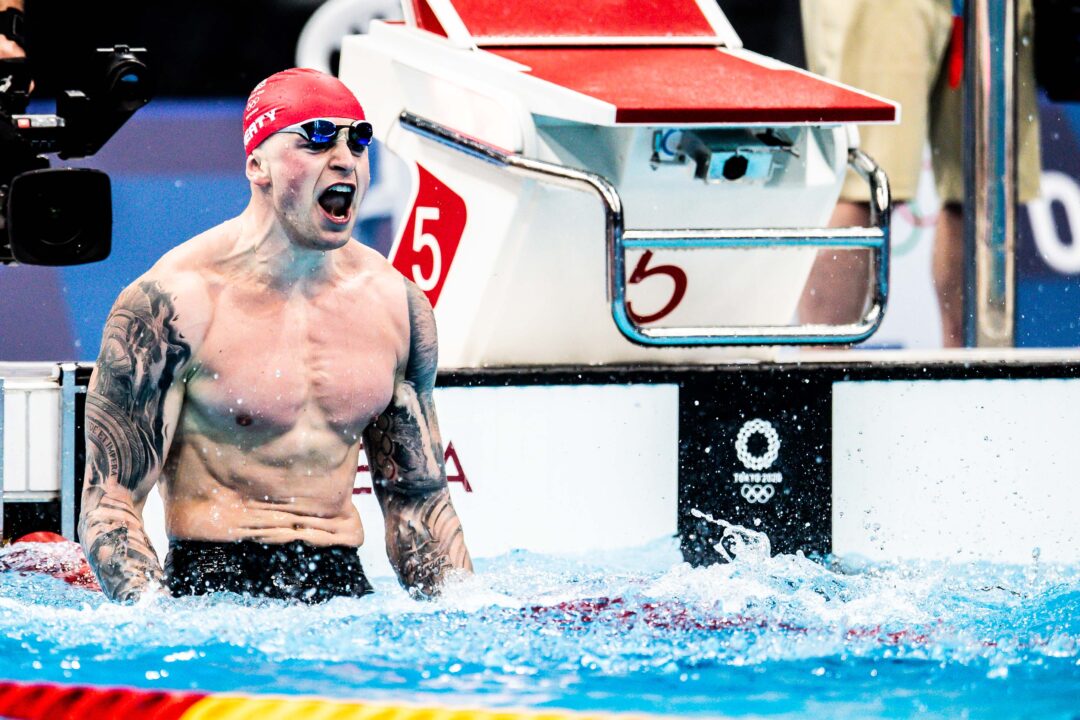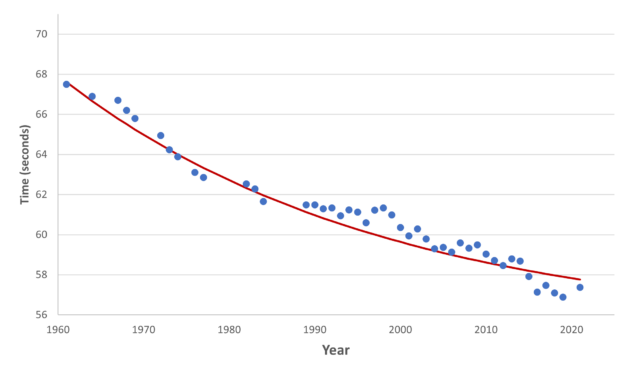This article originally appeared in the 2022 Spring edition of SwimSwam Magazine. Subscribe here.
In 2016, Adam Peaty won his first Olympic gold medal by winning the men’s 100 breaststroke in Rio de Janeiro. In the process, he set a new world record with 57.13, finishing more than 1.5 seconds ahead of Cameron van der Burgh, the silver medalist. By then, Peaty was the predominant male swimmer in in a single event and already one of the greatest swimmers of all time.
During 2017, he and his coach Mel Marshall launched “Project 56.” He wanted to enter the 56-second territory at a time when much of the world still couldn’t believe that someone had broken 58. Said and done. During the 2019 World Championships in Gwangju, Peaty set a 56.88, which stands as the world record as of today.
Having won his second Olympic gold medal in the event in Tokyo last year, and being unbeatable in the 100 breaststroke since 2014, Peaty is still setting some very ambitious challenges for himself. Now he is looking ahead to what he and Marshall term “Project Immortal.” In his own words, “Doing a time that can never be beaten — the next three years is how we achieve Project Immortal.”
Peaty has been in a league of his own since he first cracked the 58-second barrier in 2015. He has been setting world records that few people believed to be possible in our era. Now, he wants to go beyond that and set a time that can never be beaten.
An impossible goal?
Sad news for him: This is unlikely to happen. Probably, 300 years from now, swimmers will be setting times so fast that we can’t even imagine today — just like 56.88 would have sounded insane 40 years ago. We might think that, someday, someone will be able to complete swimming the 100-meter breaststroke in 53 seconds.
In fact, it has been computed. In 2020, a very interesting scientific paper was published in the Journal of the Royal Statistical Society, one of the most renowned journals in statistics. It’s entitled Ranking, and other properties, of elite swimmers using extreme value theory, by Harry Spearing, Jonathan Tawn, David Irons, Tim Paulden and Grace Bennett, from Lancaster University. The researchers aimed to estimate the limits of human performance using data and statistical methods, and they concluded that the ultimate world record in the men’s 100 breaststroke is 53.81.
That should be the goal for Peaty in his “Project Immortal.” And, obviously, it sounds crazy. We propose another goal for him (still ambitious, though). What date could he pass on so he will never see anyone beat it? In other words, a world record that would stand as long as Peaty lives.
A new “Project Immortal”
The graph below shows the times of the fastest swimmers in the world in the men’s 100 breaststroke by year since 1960. We can see a clear decaying pattern, which is not surprising.
Fastest times in the world in the men’s 100 breaststroke over the years
Of course, the decaying pattern was more dramatic in the first years. Then it started to stabilize, as shown by the dotted line. The line represents an exponential function, obtained by a mathematical procedure called nonlinear regression, and it is the best approximation to the data in mathematical terms.
(Note: The world leading times in 2008 and 2009 have been adjusted in order to remove the effect of the now-outlawed high-tech suits, using a statistical methodology detailed in SwimSwam Magazine’s 2021 Olympic Preview.)
This approach is a simple way to have an idea of the ultimate world record, since it converges toward a time limit. In this particular case, the function indicates a time limit of 53.99, which is very close to the ultimate world record estimated by the 2020 scientific paper. Also, we can estimate the world record in any given year. This is the link with the “Project Immortal.”
Since our goal is to estimate a world record that could last while Adam Peaty lives, maybe we can think that 80 years from now a world record that Peaty would set now would be expected to be matched only in the year 2100.
For those who are interested, the mathematical function is:
time = 53.99 + 13.81 × e –0.021 × year
Where e = 2.7183 is a number called Euler’s number. It is as important in mathematics as π — this one you may know. (In this formula, the year is defined so that 1960 is the year 0. So, 2022 is the year 62, and 2100 is the year 140.)
Interestingly, by this function, the world record today would be 57.83, which is very close to the best time of the second-fastest performer in history — 57.80 by Dutch swimmer Arno Kamminga. This seems reasonable, since Adam Peaty is truly an outlier.
In 2100, the estimated world record is 54.72. In the last 60 years, we have seen the world record fall by 10 seconds. It is natural that, as time goes by, the improvement rate is getting smaller. In the next 78 years, by this projection, the record will be improved not by 10 seconds, but by two seconds. And yet, 54.72 seems beyond our imagination.
This is our suggestion for a time goal for Peaty. It would be an immortal world record as long as he lives.


umm
I can’t see why they’ve plotted the fastest times of each year. Some years there would be no world championships or Olympics so the best athletes would be training through the competitions. This will give slower swims for those years which don’t reflect what the swimmers were actually capable of those years Surely it would be better to just plot the world records and when they were achieved?
Milak in the 200 fly is my vote for Project Immortal.
He looks like Secretariat in that last 50 of his 200 fly. Secretariat was found to have an oversized heart. I wonder if Milak has one too.
Ooh this is a good thought experiment – what current swimmer could put a WR out of reach for the longest time?
A few of Ledecky’s might be there as well as Sjostrom’s 50 fly. For men I think Milak vs Peaty could be the battle, and hell, if Milak ever has a fully uninterrupted training block again he could push the 2 fly further out of reach than Peaty’s 199 breast.
The current longest reigning one is Hackett’s 800 Free SCM. He set it in 2001. It has only been beaten once, by himself in a super suit. He has the only swim from the pre SS era to never be beaten by another swimmer.
I saw the graph with dots and had flashbacks to doing lines of best fit in math class….
I struggle to see how a 54 is humanly possible without a rule change, let alone 53.
A 55 isn’t that unimaginable, imagine someone with Peaty’s stroke and Dressel’s start/walls.
Yeah, 3:40 has been the WR in 400fr for over 20 years, so it’s not a given that Peaty’s WR as is will be beaten by anyone in the next 20 years.
have these mathematical functions matched up with track and field world records?
Daniel, based on this mathematical function, when is rubberized 20.91 going to get beat ?
Also in which year will the first human go 19.9 sec in the 50 free LCM ?
Peaty with the amazing feats he acomplished over the years is already immortal. Well done PEATY!